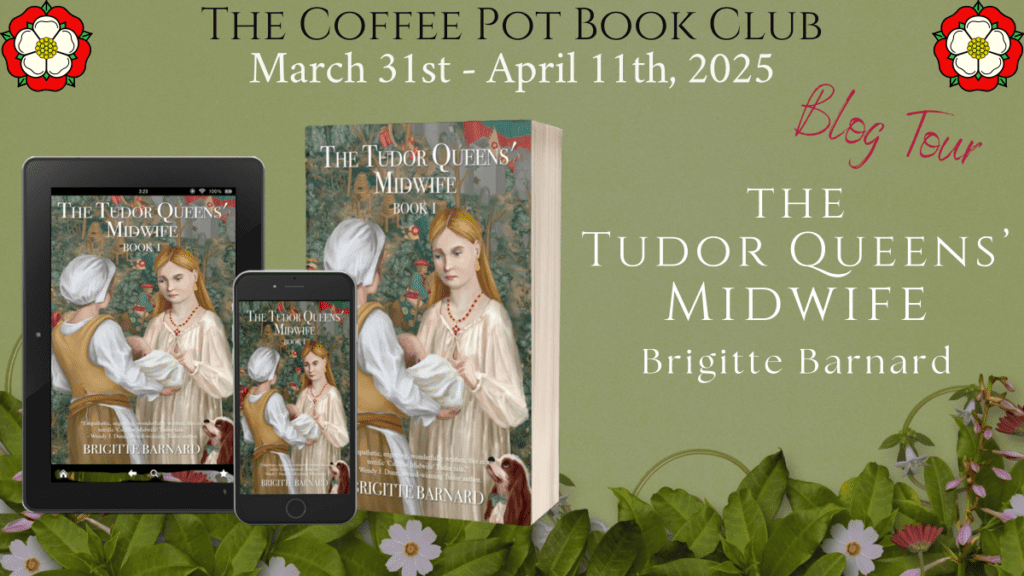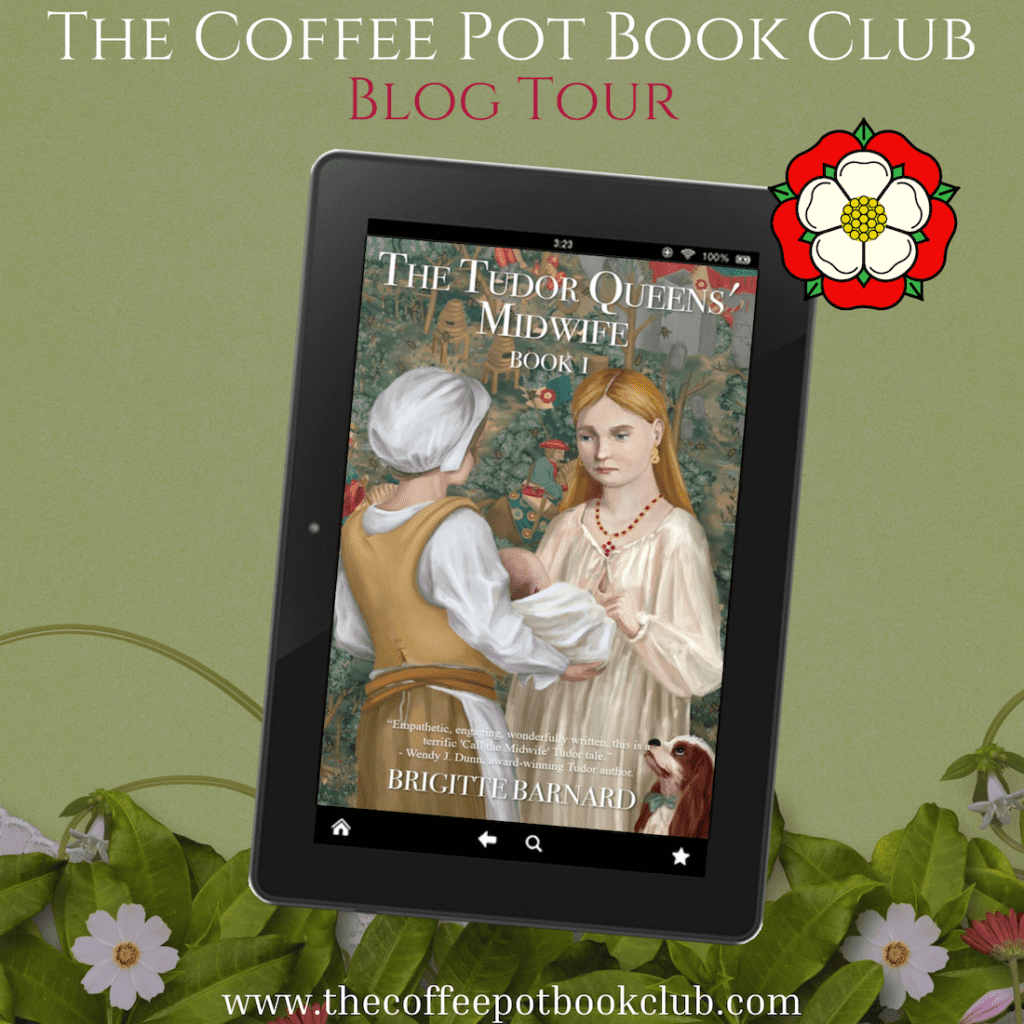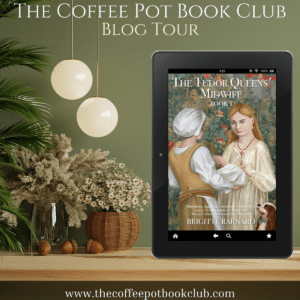
08 Apr Brigitte Barnard The Tudor Queens’ Midwife #TheTudorMidwife #HistoricalFiction #TudorFiction #BlogTour #TheCoffeePotBookClub @thetudormidwife @cathiedunn
FEATURED AUTHOR: BRIGITTE BARNARD
I‘m delighted to welcome Brigitte Barnard as the featured author in The Coffee Pot Book Club Blog Tour being held between March 31st – April 11th, 2025. Brigitte Barnard is the author of the Historical Fiction / Tudor Fiction, The Tudor Queens’ Midwife (The Tudor Queens’ Midwife, Book 1), independently published by the author on January 3rd, 2025 (299 pages).
Below are highlights of The Tudor Queens’ Midwife, Brigitte Barnard’s author bio, and a heartbreaking excerpt from her book.

Tour Schedule Page: https://thecoffeepotbookclub.blogspot.com/2025/02/blog-tour-the-tudor-queens-midwife-by-brigitte-barnard.html
HIGHLIGHTS: THE TUDOR QUEENS’ MIDWIFE

The Tudor Queens’ Midwife
(The Tudor Queens’ Midwife, Book 1)
By Brigitte Barnard
Blurb:
In the glamorous, glittering and dangerous court of king Henry VIII and his queen Katherine of Aragon, the desperate desire for a healthy male heir overshadows all. Plagued by a series of miscarriages the queen is left grappling with the weight of her singular duty to provide a son for the Crown. Amidst this turmoil the queen turns to Sarah Menendez, the most highly skilled midwife in England. Sarah, exiled from her homeland and concealing her true identity must serve the queen and battle her deepest fears. As Sarah strives to save the queen from the perils of childbirth, the specter of her own past threatens to unravel the carefully crafted identity Sarah has created for herself and her young daughter.
In a world where power, politics and religion collide, Sarah finds herself entangled in a web of intrigue and deadly danger. The fate of the queen’s unborn child, the survival of the midwife and her daughter, and the stability of the kingdom hang in the balance. Sarah Menendez must employ all of her skills, cunning and courage to protect those she holds dear as well as the life of the queen and her unborn child.
The Tudor Queens’ Midwife is a gripping tale of secrecy, sacrifice and religious turmoil amongst the most opulent court the world has ever seen.
Trigger Points: Stillbirth
Buy Link:
Universal Buy Link: https://books2read.com/u/4jzxyk
AUTHOR’S BIO: BRIGITTE BARNARD

Brigitte Barnard is an amateur historian of Renaissance English history and an author of the trilogy The Tudor Queens’ Midwife, of which the first book in the series is available. She is currently writing a non-fiction book about Tudor midwifery for Pen and Sword publishing house.
Brigitte is a former homebirth midwife, and she lives at home with her husband and four children. She also raises Cavalier King Charles spaniels.
Author Links:
Website: http://thetudormidwife.com/
Twitter: https://x.com/TheTudorMidwife
Instagram: https://www.instagram.com/thetudormidwife
EXCERPT: THE TUDOR QUEENS’ MIDWIFE

The queen is struggling, and it’s still only twelve hours into her labour—she can be at this for much longer if I’m any judge.
Katherine then addresses her friend, “Maria, will you please give me my rosary so that I might pray?”
Maria de Salinas reaches into a little velvet bag on a rosewood table beside the bed. She places in the queen’s hands her ivory and diamond rosary, and the queen begins saying her rosary over and over again. The contractions seem to have subsided—yet another bad sign.
I motion to my daughter, and she gets uprises from the bed and comes to stand next to me.
I walk her over to the corner of the room, saying quietly in her ear, “I’m starting to feel concerned… this labour… I don’t know, there’s something wrong. I can’t put my finger on it, but I also can’t shake this feeling that something’s not right. I’m going to brew her an herbal draught that I hope will strengthen her womb. What should I put in it?”
My daughter is my apprentice. I am teaching her everything I know so she will one day follow in my footsteps and become the most competent midwife I can train her to be.
“I think we should try making her a tea with red raspberry leaves and perhaps some angelica root and, I don’t know, maybe some willow bark?”
“Excellent. Please go into my bag and pull out those herbs. I also want you to put aside some pennyroyal in case we need to use it, but I hope we won’t.”
As my daughter is gathering the herbs together, I walk over to the group of ladies and ask one of them if she could please go and fetch me a goblet of mulled wine sweetened with honey for the queen. A young woman jumps up, happy to be assisting the midwives and bustles out of the room to find a steward to go to the kitchens for her.
When everything is prepared to my satisfaction, I place the goblet of warm spiced wine and steeped herbs into the queen’s hands.
“Drink this, Your Majesty. It has honey and specially prepared herbs that will fortify your labour.”
Queen Katherine puts aside her rosary and, raising the goblet to her lips, takes a sip.
“Come now, Your Majesty, drink that all down,” I say encouragingly.
The queen motions to my daughter, “Come here, child.” Dutifully, my daughter comes to stand in front of Katherine. “Did I hear your mother call you Faith?”
My daughter glances over at me. I nod my head imperceptibly.
“Yes, Your Majesty,” she says.
“Such a beautiful name,” says the queen. “And you are a good Christian girl? You study your catechism every day?”
My daughter’s eyes are downcast, firmly fixed on the floor beneath her, but she answers readily. “Oh, yes! Mother gives me lessons every day.”
“That is good,” says Katherine. “Your mother is very lucky to have such an avid pupil.”
The queen’s Spanish companion is watching this scene, studying my daughter closely through narrowed black eyes.
A jolt of fear grips my heart when I see Maria de Salinas scrutinizing my daughter. I recognize the look and a cold terror grips my very bowels. She knows who we are, I think. I say out loud, “Faith, where have you misplaced the tincture of pennyroyal? Please come here and find it for me!”
My puzzled daughter looks over at me, and I give her a frown. She bobs a little curtsy to the queen and comes over to where I’m standing, pretending to search in my bag for the missing herb.
“Mama, what??”
“Shh!” I interrupt my daughter before the words are out of her mouth. Reprimanded, my daughter hangs her head but doesn’t utter another word.
I look over at the queen, and the Spaniard’s dark gaze is still fixed on us.
“We should also try to rest a bit while the queen’s labour has a bit of a respite. I have a feeling we’re going to be here for quite some time, so let’s try and take advantage and rest a spell,” I say quietly to my daughter.
We retire to the small pallet in a corner of the queen’s room and pull the thin silk coverlet up over ourselves. The queen’s retinue follows our example, huddling down together on a large, low bed on the other side of the queen’s bedchamber.
It’s not more than two or three hours later when the queen’s pains start up again. Groggily, I make my way over to the queen’s bed and ask her if I may examine her again. Katherine winces as I slide my two fingers inside her and feel the mouth of the womb, which is now much thinner and more open. When I withdraw my fingers, I am satisfied to see some bloody mucus. This is a good sign that her labour is well and truly underway.
We are all exhausted at this point, when the queen’s demeanour changes. She climbs back into the bed, moving around, trying desperately to find a comfortable position. I watch her, but I don’t direct her. In my experience, it’s always best to leave the labouring woman alone and let her find her own way.
The queen moves onto all fours and begins to rock back and forth, moaning rhythmically. I move behind her, and my daughter comes to stand next to me. The moving stops, and the queen shrieks.
“¡No puedo hacer esto, María! ¡hazlo parar!”
Maria knits her brows together, but her voice is calm as she replies “Puedes hacer esto, eres fuerte y pronto sostendrás a tu hijo!”
The rocking becomes more frantic, and the queen loses control as the urge to bear down takes over.
“Now, Your Majesty, take a deep breath, and when you feel the next pain, I want you to bear down like you do when you are moving your bowels.”
I push the queen’s night rail up over her hips. She makes a low moaning sound deep in her throat and strains as she bears down with her pain.
“That was good, Your Majesty, take deep breaths in and out.”
The queen rests between pains, her head falling low, her whole body visibly relaxing. This pattern repeats itself until the queen screams, and a little head is visible between the queen’s legs.
“Excellent, Your Majesty! I can see the baby’s head! Now, on your next pain, I want you to hold your breath and push as hard as you can.”
Katherine gives a mighty push on the next contraction, and a little baby slithers out. The baby is so tiny. My daughter and I exchange looks. I quickly cut the cord and give the baby to my daughter, and she whisks the baby off. I deliver the afterbirth and put the placenta into a linen towel to be examined later.
One of the queen’s little ladies-in-waiting announces to the guard outside the bedchamber that the baby has been born. The king will be on his way to the queen’s bedchamber shortly. Katherine’s women are helping her into a fresh gown before she climbs into her velvet-draped tester bed. I get up and join my daughter, who is holding the queen’s baby daughter.
The queen’s baby is blue, not breathing, and her limbs are floppy. I rub her briskly with linen towels, but there is no response. I try breathing into her tiny mouth—nothing. The baby is dead, and there is nothing I can do to change that fact. Horrified, my daughter’s eyes hold my gaze as the tears well up. I set my mouth together firmly and briskly shake my head at her once. That’s all she needs to pull herself together. Maria, Katherine’s friend, helps the queen settle back onto her pillows, where she’s resting comfortably.
“Let me see my baby! I want to hold my baby! Why don’t I hear him crying?”
“Rest now, querida,” says Maria, “everything is fine. The midwives are bringing him to you.”
I carry the grim little bundle over to the queen.
“I’m so sorry, Your Majesty. Your baby girl is already in heaven.”
The distraught queen lets out a shriek I will remember until my last breath on this earth. No one with a heart could hear such a wail of pure, gut-wrenching agony and not understand the pain that the queen is consumed by. Her first baby, her husband’s heir, dead before she could even draw a breath. The queen’s ladies-in-waiting stand around the bed, some with tears running down their cheeks, others looking shocked and numb.
Maria takes the queen in her arms, and the two rock gently back and forth together as their mingled tears stains the bedclothes. My daughter and I walk over to the other side of the room with the baby’s corpse still in my arms. We wrap the little infant in linen towels and place her gently on the sideboard.

 Twitter: @cathiedunn
Twitter: @cathiedunn
Instagram & Threads: @thecoffeepotbookclub
Bluesky: @cathiedunn.bsky.social


Cathie Dunn
Posted at 02:39h, 08 AprilThank you so much for hosting Brigitte Barnard today, with such a moving excerpt from her new novel, The Tudor Queens’ Midwife.
Take care,
Cathie xo
The Coffee Pot Book Club
Linnea Tanner
Posted at 12:32h, 11 AprilHi Cathie—It was my pleasure to feature Brigitte Barnard and learn about her book about the Tudor midwife.
robertawrites235681907
Posted at 12:29h, 11 AprilMy mother loves this period. I’ll look for this book for her. Thanks Linnea.
Linnea Tanner
Posted at 12:40h, 11 AprilHi Robbie—Thank you for visiting and commenting. It’s great to learn that your mother loves this period. I’m also fascinated with King Henry VIII and his wives. It’s intriguing to have the midwife’s perspective because bearing a living heir had significant consequences on England’s history.
robertawrites235681907
Posted at 06:50h, 12 AprilYes, you are right. It is an interesting period in history